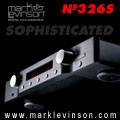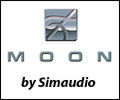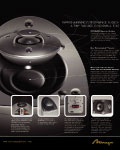By Wes Phillips
Getting a Fix on the Good Stuff
 We audiophiles have special needs—and I don't just mean a way to print our own money, or, failing that, to get our dream systems for Sam's Club prices. Of course, we're always lusting after the good stuff, but most of us have accepted the fact that audio purchases rank among those pleasures where our eyes—and ears—will always be bigger than our pocketbooks. Music, on the other hand, is an area where every audiophile I've ever met is a greedy little sucker.
We audiophiles have special needs—and I don't just mean a way to print our own money, or, failing that, to get our dream systems for Sam's Club prices. Of course, we're always lusting after the good stuff, but most of us have accepted the fact that audio purchases rank among those pleasures where our eyes—and ears—will always be bigger than our pocketbooks. Music, on the other hand, is an area where every audiophile I've ever met is a greedy little sucker.
"Please, sir, I want some more."
But where do we get it? Yard sales, thrift shops, second-hand stores, and all the mega media marts provide LPs, CDs, and any other format we might feel passionate about. But that begs the big question: How do we discover what it is we want to buy?
Of course, we can read reviews. My living room and office are carpeted with copies of Stereophile, Mojo, Uncut, and their ilk (which says as much about my housekeeping as it does about my reading habits), but—and as a reviewer, I hate to admit this—reviews don't always tell you what you need to know.
If you're lucky, you get recommendations from friends. However, judging from the mail I get from audiophiles, a lot of us tend to be the friend who is making the recommendation.
John DeVore of DeVore Fidelity gave props to his fellow audiophiles. "Every audiophile I know in the New York hi-fi world has a cool new record he wants to share (obsessively, perhaps)." John also keeps his ears open: "When I hear something I like, I write it down. Periodically I have to go through great piles of paper scraps with notes jotted on them—napkin corners, ATM receipts, and Post-its that have lost their adhesive. Eventually most things make it to one of two notebooks, where they get little symbols next to them, indicating approximate genre, format (LP/CD/other), and how good I remember they were. It's not foolproof by any stretch—many little scraps never make it near a notebook before I trash 'em—but I know the limitations of my memory, and it's the best system I've come up with."
I asked John Atkinson what he does. "I read the reviews in Stereophile," he said, "especially our "Recording of the Month" and "Records to Die For" features—hardly a shock, coming from the man who once suggested that one of the primary pleasures of hardware reviews was the discovery of new music. "I talk to my writers and friends, surf the audio newsgroups and websites, and pore over the Acoustic Sounds mailer."
I bet he keeps his copy in the same room I keep mine in.
Stereophile.com's webmaster, Jon Iverson, DJs at San Luis Obispo's KCBX 90.1 FM, which means he gets to prepare for his show with weekly search'n'destroy missions through the station's new-releases pile. He also browses Web radio, seeking stations with fresh playlists, and cruises the samples at www.iTunes.com. "The samples at iTunes work better than the ones at Amazon.com—and I'm just listening to see if I like the music, not for sound quality."
Stereophile writer Barry Willis is an omnivore. "My antenna is always up for new tunes. I keep a notepad handy. Friends are a great resource, and I never hesitate to ask about the music I hear in cafes, restaurants, and stores. I'll buy stuff I like on impulse if I hear it when I'm in a record store."
But BW is over the top about Sirius Satellite Radio. "Especially channel 24, Sirius Disorder, and extra especially David Johansen's Mansion of Fun, on Friday afternoons. I haven't listened to commercial radio or used my car CD changer since I got Sirius."
Heh-heh.
Does it come from the sky above?
I'm going through a similar conversion now that Polk Audio has sent me a sample of its new XRt12 XM Satellite Radio tuner ($329). It has a feature that must have been designed with relentless music seekers like me in mind: the Memory button. If I hear something I like, all I have to do is press the XRt12's front-panel Memory button and it will retain the text scroll identifying the artist and song (10 songs total); later, I can access the Memory Recall function and get out my notepad.
Despite BW's advocacy of digital audio broadcasting (DAB), I wasn't sure I was going to "get" satellite radio. First, I wasn't wild about paying a monthly fee. Of course, on the television front, I became inured to that years ago—mostly because, if I wanted decent programming, there was no other choice. However, the current state of over-the-air (OTA) radio is even direr than OTA TV.
Besides, I'd dabbled with XM a while back, auditioning Sony's original car/home satellite receiver, a product whose mediocre sound quality was surpassed only by its phenomenally clunky user interface. But the Polk XRt12 was bruited as a horse of a different color.
For one thing, it wasn't a product scaled down to be slipped into a docking cradle in a dashboard or boombox—it was designed around a component-sized (17" wide) chassis and packed with a Burr-Brown DAC, a special power supply, a high-quality adjustable gain card, and a circuit topology that places the power supply, display, outputs, preamp, and tuner on discrete circuit boards in the quest for lower noise/minimized interference.
It also has something I've never seen on a satellite radio tuner: digital outs. The analog outputs sound surprisingly robust, with solid bass and timbre that were extremely natural compared to what I'd heard emanating from the Sony. Attach the XRt12 to a fancy-schmancy outboard DAC, however, such as the Musical Fidelity X-DACV3 I had on hand, and it gets even better.
Which is sort of shocking, when you consider the compression necessary to make XM work at all. JA and JI attended "Mastering for Low-Bit-Rate Perceptual Codecs," a workshop at the 117th AES Convention in November, which included Tony Masiello, XM's senior vice president of operations. According to his presentation, as reported by Stereophile's editor, a stereo channel on a DAB network has, at best, a bit budget of just 64kbps. (This is not a figure XM or Masiello gives out, but divide the overall satellite bandwidth by the number of program channels and that's what you get.) In order to encode music to fit that budget without sounding terrible, XM begins with the CD data—not an MP3 or reduced-data recording—and then the XM codecs do the hard labor at both ends of the process. The good news is that codecs evolve with incredible velocity.
If I say that my initial experience with XM is that the sound is better than the average FM station, that's faint praise. But I think it's better than that—at least through the Polk XRt12. If you're looking for deep, holographic soundstaging, you'll be disappointed—it simply isn't there. But, as does JI with Web radio and iTunes, I find that the real value of XM has been the amount of music I've heard that I want to explore further.
My first few days were spent exploring the usual suspects: the three classical channels, the folk channel, the five jazz and blues channels—even Deep Album Rock. In each case I heard a lot of music I already knew, as well as a lot I hadn't heard for a long time that I was delighted to rediscover. My real voyage of discovery began when I delved into channels featuring music I didn't already know I liked. New genres equal new experiences. D'oh!
The Unsigned Artists channel was a revelation, though it shouldn't have been. The record labels don't exactly have an unblemished record of discovering interesting new music, despite the fact that there's a lot of it out there. Much to my shock, I actually like The Voice of Music at Starbucks, which is programmed very intelligently—and I don't have to cruise endlessly for an empty table while clutching a cup of burnt coffee in order to hear it. Another shocker: Movie Soundtracks, which is an area where I never venture in the record store. I may have to reconsider.
By and large, I've been impressed with the DJs and music directors at XM. Jonathan Schwartz at Frank's Place is a national treasure, for example; Webb Wilder is the principal host at X Country—and Tom Petty is slated to do a show called Buried Treasure. That doesn't mean there aren't glaring gaps. I wish there was a place for the real jewel of the free-form radio movement, the theme show. If it exists anywhere on XM, I haven't found it yet.
And the classical programming could be fresher. Popular Classical is warhorses all the time, which has its place, I suppose, but seems pretty unadventurous to me—as does Traditional Classical, although it does play more serious stuff. Opera/Classical Vocal rounds out the highbrow offerings, and that's a genre that's almost completely absent from the airwaves these days.
But no channel of serious 20th-century music? That seems a deliberate snub to the 46 of us who listen to the stuff. And no early music? That seems like a gaping hole that really ought to be filled.
Stereophile's E-Newsletter to the rescue with a recommendation.
If you crave some new old music, pick up a copy of Telarc's new hybrid disc of Mozart's flute concertos and Symphony 41, "Jupiter," by flutist Jacques Zoon and the Boston Baroque under Martin Pearlman (Telarc CD/SACD-80624). As an audiophile, you've got to love the fact that it's available as a DSD SACD and a "Red Book" CD. Jack Renner, as usual, has done a fabulous job of capturing an acoustic ensemble in a real space (this is done especially subtly on the SACD surround mix), but for this disc he chose a slightly closer perspective than Telarc is usually noted for. I've never objected to Telarc's mid-hall take on things, because that's where I sit by choice (well, budget) when I attend concerts, but the closer perspective suits the musical forces on this disc.
On this recording Zoon plays a six-key classical flute (after a late-18th-century instrument by August Genser). It's tuned slightly lower than modern concert pitch, and its warm, earthy breathiness is very appealing—as are the stylish performances by Zoon, Boston Baroque, and Pearlman.
It's a recording that rebukes Holt's Law: "The Better the Sound, the Worse the Performance."
Mix Tapes & Money, By Wes Phillips
I'm surprised no one I surveyed mentioned mix tapes (mix CD, these days). We music-loving audiophiles are past masters of them. I cringed when I read Nick Hornby's High Fidelity, with its compulsive "best of" lists and its protagonist's love offerings of mix tapes. That's because I make them—and give them—all the time. In fact, I made one recently concerning money, honey.
I'm sooo envious of Ken Kessler, who got to raid the Ace vaults in 1994 to create a Hi-Fi News & Record Review CD. We don't have the bandwidth or the licensing for that here, so I'll just post my track listing:
Money: That's What I Want!
"Money (That's What I Want)" Barrett Strong
"Money" Pink Floyd
"Your Cash Ain't Nothin' But Trash" Steve Miller Band
"Don't Let Your Deal Go Down" Dave Alvin
"It's Money That I Love" Randy Newman
"Shake Your Money-Maker" Paul Butterfield Blues Band
"Loan Me a Dime" Boz Scaggs
"Buddy, Can You Spare a Dime?" Bing Crosby
"How Can a Poor Man Stand Times and Live?" Blind Alfred Reed
"Greenbacks" Ray Charles
"Fourteen Dollars in the Bank" The Paul Delay Band
"Badly Bent" The Tractors
"Dead Presidents" Willie Dixon
"Eisenhower Blues" J.B. Lenoir
"Funky Dollar Bill" Funkadelic
"Money Won't Change You" James Brown
"When Will We Be Paid (For the Work We've Done)?" The Staple Singers
"You Can't Lose What You Ain't Never Had" Muddy Waters
"God Bless the Child" Billie Holiday
"Money and Me" Barrett Strong
"Money" Cabaret: The New Broadway Cast Recording
"Can You Get to That" Funkadelic
"Money for Nothing" Dire Straits
"Money Talks" The Kinks
"First I Look at the Purse" The Contours
"Money Honey" The Drifters
"TCB/TYA" Bobby Patterson
"You Never Give Me Your Money" The Beatles
"Step Right Up" Tom Waits
"Nobody Knows You When You Are Down and Out" Louis Jordan
"Back Country Suite: Blues/Old Man Blues" Mose Allison
"Where's the Money?" Dan Hicks
"The Hold Up" David Bromberg
"Me and the IRS (Live)" Johnny Paycheck
"My Bank Account Is Gone" Jesse Ashlock
Comments? Suggestions? Mix tapes?

 The more you'd like things to stay the same, the more you become aware of the need for change, I mused, as I took in Tony Bennett's concert at New York's new Jazz at Lincoln Center location last week. Aided by the Rose Theater's intimate acoustic and backed by a classic quartet of guitar, piano, double bass, and drums, the 78-year-old crooner effortlessly worked his way through almost two hours of standards.
The more you'd like things to stay the same, the more you become aware of the need for change, I mused, as I took in Tony Bennett's concert at New York's new Jazz at Lincoln Center location last week. Aided by the Rose Theater's intimate acoustic and backed by a classic quartet of guitar, piano, double bass, and drums, the 78-year-old crooner effortlessly worked his way through almost two hours of standards.

 With the analog revival showing no signs of flagging, the flood of new tonearms, cartridges, and turntables was to be expected. So how about a moving-coil (MC) cartridge from South Africa? Music lover André Hanekom, whose background is in watch distribution, says that, "Four years ago, I bought a Supex SD900 Super II and found that it was damaged upon arriving at home. Three months later, I managed to repair it myself, and this caused what may be termed an obsession to make my own moving-coil."
With the analog revival showing no signs of flagging, the flood of new tonearms, cartridges, and turntables was to be expected. So how about a moving-coil (MC) cartridge from South Africa? Music lover André Hanekom, whose background is in watch distribution, says that, "Four years ago, I bought a Supex SD900 Super II and found that it was damaged upon arriving at home. Three months later, I managed to repair it myself, and this caused what may be termed an obsession to make my own moving-coil."

 We audiophiles have special needs—and I don't just mean a way to print our own money, or, failing that, to get our dream systems for Sam's Club prices. Of course, we're always lusting after the good stuff, but most of us have accepted the fact that audio purchases rank among those pleasures where our eyes—and ears—will always be bigger than our pocketbooks. Music, on the other hand, is an area where every audiophile I've ever met is a greedy little sucker.
We audiophiles have special needs—and I don't just mean a way to print our own money, or, failing that, to get our dream systems for Sam's Club prices. Of course, we're always lusting after the good stuff, but most of us have accepted the fact that audio purchases rank among those pleasures where our eyes—and ears—will always be bigger than our pocketbooks. Music, on the other hand, is an area where every audiophile I've ever met is a greedy little sucker.
